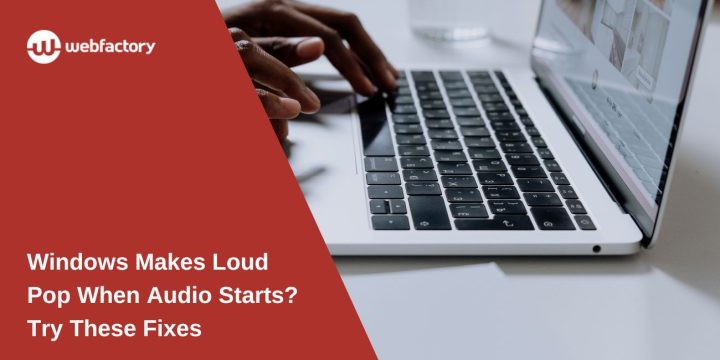If you hear a loud “pop” or “click” sound every time your PC starts playing audio—whether it’s a YouTube video, a system notification, or a music file—you’re not alone. This issue is frustrating and often makes users worry that their speakers or headphones are damaged. The good news? It’s usually a software or driver issue, not a hardware failure.
This guide will explain why this happens and walk you through several working fixes.
Why Does This Popping Sound Happen?
The pop sound you hear at the start of audio playback is often caused by how Windows or your sound driver handles audio when idle. Many sound systems go into a low-power or “standby” mode to save energy when no sound is playing. When the system wakes up to play audio, it doesn’t always ramp up smoothly—leading to a quick jolt or pop in your speakers.
This is common with:
- Realtek audio drivers
- USB audio interfaces
- HDMI audio output
- External DACs or Bluetooth speakers
In some cases, the audio driver or amplifier doesn’t mute the signal properly when reactivating, which causes the loud pop.
Common Scenarios Where It Happens
Here are the most frequent situations where users notice the pop sound:
- Playing the first audio after a few seconds of silence
- Watching a YouTube video after being idle
- Switching from one audio device to another (e.g., HDMI to headphones)
- Waking the PC from sleep or hibernate
- Connecting USB speakers or a USB headset
Understanding when it happens helps identify the cause and apply the right fix.
How to Fix Loud Pop Sound When Audio Starts on Your PC
Here Are Some Practical Steps You Can Try to Fix the Pop Sound on Audio Start:
1. Turn Off Audio Enhancements in Windows
Audio enhancements like virtual surround or bass boost can interfere with the driver and cause popping noises.
To disable them:
- Go to Control Panel > Sound
- Under the Playback tab, right-click your default audio device and choose Properties
- Click on the Enhancements tab
- Check Disable all enhancements
- Click OK
Play any audio to test if the pop still occurs.
2. Disable Exclusive Mode for Playback Devices
Exclusive mode allows certain apps to take full control of the audio driver, which can trigger delays and popping.
To disable it:
- Go to Control Panel > Sound > Playback
- Right-click your audio device > Properties
- Click the Advanced tab
- Uncheck:
- Allow applications to take exclusive control of this device
- Give exclusive mode applications priority
- Apply and exit
Restart the audio or system and check again.
3. Update or Roll Back Your Audio Driver
Driver mismatches or bugs can cause audio glitches, especially after Windows updates.
Here’s how to check:
- Press
Win + Xand choose Device Manager - Expand Sound, video and game controllers
- Right-click your sound driver (e.g., Realtek or Intel Display Audio)
- Choose Update driver or Properties > Driver tab > Roll Back driver if the option is available
- Reboot your PC
If a recent update caused the issue, rolling back might resolve it.
4. Try Switching to the Microsoft HD Audio Driver
Sometimes, Windows’ generic audio driver is more stable than your device’s manufacturer driver.
To install it:
- In Device Manager, right-click your audio driver
- Choose Update driver
- Select Browse my computer for drivers
- Click Let me pick from a list of available drivers
- Select High Definition Audio Device (not Realtek)
- Click Next and let it install
Restart and test your audio again.
5. Change Your Power Settings
Power-saving features can cause the system to shut off your audio hardware during idle time, leading to pops when reactivated.
To adjust this:
- Open Control Panel > Power Options
- Click Change plan settings next to your active plan
- Choose Change advanced power settings
- Set USB selective suspend setting to Disabled
- Under PCI Express > Link State Power Management, select Off
- Make sure you’re using the High Performance power plan
Apply changes and restart your PC.
Advanced Fixes (If the Problem Still Happens)
If the issue still exists, try these more advanced methods:
- Use an external USB DAC or audio interface: These devices often have better power handling and isolation, which reduces noise and pops.
- Avoid USB 3.0 ports for audio: Some USB 3.0 ports cause interference. Try switching the DAC to a USB 2.0 port.
- Use ASIO or WASAPI drivers: If you’re doing professional audio work, using low-latency drivers helps avoid power-saving interruptions.
- Check BIOS audio settings: Some motherboards allow toggling “Audio Standby” or “HD Audio” features that may be related.
Final Tips and Prevention
Once the issue is fixed, these tips can help avoid it from coming back:
- Avoid switching audio devices during active playback.
- Keep your sound drivers updated—but always from official sources.
- Use shielded audio cables, especially for analog outputs.
- If you’re using HDMI audio, check your TV/monitor settings for audio delay or “smart sound” features and disable them.
You don’t have to live with that annoying pop sound every time your system plays audio. Most of the time, the cause is driver-related or tied to Windows audio settings—and that means you can fix it without new hardware.
If this helped fix your problem, feel free to share this article or leave a comment about which solution worked for you.
